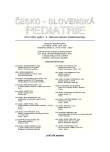Intravenous Glucose Tolerance Test in Differential Diagnosis of Randomly Found Hyperglycaemia in Children and Adolescents
Authors:
E. Feigerlová 1; Š. Průhová 1; D. Pintérová 2; K. Kološtová 2; M. Černá 2; J. Lebl 1
Authors‘ workplace:
Klinika dětí a dorostu 3. LF UK a FN Královské Vinohrady, Praha
přednosta prof. MUDr. J. Lebl, CSc.
1; Oddělení buněčné a molekulární biologie 3. LF UK, Praha
vedoucí doc. RNDr. J. Kovář, DrSc.
2
Published in:
Čes-slov Pediat 2005; 60 (3): 119-125.
Category:
Original Papers
Overview
Aims:
A random finding of hyperglycaemia in a child or adolescent with normal BMI requires to distinguish patients with an early phase of Type 1 diabetes mellitus (T1DM), with a subtype of diabetes MODY or individuals without a demonstrable disorder of glucose metabolism. The aim of this study was to assess the validity of an IVGTT as a single initial examination of the cause of a random hyperglycaemia.
Subjects and methods:
A total of 43 children and adolescents (24 boys), 2.7–18.5 years of age (median 13.1), with normal BMI for given age and sex found to have a random hyperglycaemia (defined as a fasting plasma glucose over 5.4 mmol/l) was subject to an examination. IVGTT (0.5 g/kg of body weight glucose) was performed in all subjects. Glycaemia at time 0 and 60 minutes and levels of insulin and C-peptide at time 0 (fasting), 1+3 minutes (first phase insulin response; FPIR) and 60 minutes (second phase insulin response; SPIR) were evaluated. According to the subsequent clinical course and to results of molecular genetic examination, patients were divided into three diagnostic groups: 1. Early phase T1DM; 2. MODY2; 3. Normal glucose tolerance.
Results:
FPIR of 26 mlU/l or lower was characteristic of a praesymptomatic phase of T1DM (sensitivity 100%, specificity 98%) in the entire observed age group (age 2.7 years and higher) without taking account of the age and the degree of pubertal development. FPIR did not differ between NGT and MODY2. While having FPIR of 26 mlU/l and higher, fasting glycaemia (at time 0) was the most reliable value for distinguishing MODY2 from NGT. Glycaemia above 5.3 mmol/l gave evidence for MODY2 (sensitivity 97%, specificity 100%). Diagnosis of MODY2 is to be subsequently confirmed by molecular genetic examination. The other values obtained during the IVGTT were only of minor significance.
Conclusions:
IVGTT is a very reliable method for distinguishing the most frequent causes of a random hyperglycaemia in children and adolescents with normal BMI for given age and sex.
Key words:
FPIR (first phase insulin release), IVGTT (intravenous glucose tolerance test), MODY (maturity onset diabetes of the young), T1DM (type 1 diabetes mellitus)
Labels
Neonatology Paediatrics General practitioner for children and adolescentsArticle was published in
Czech-Slovak Pediatrics

2005 Issue 3
Most read in this issue
- Intravenous Glucose Tolerance Test in Differential Diagnosis of Randomly Found Hyperglycaemia in Children and Adolescents
- Renal Corticomedullary Abscess
- Obesity at the Childhood
